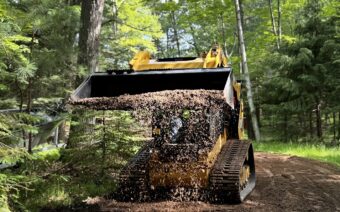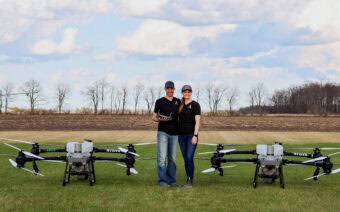
March 4, 2024
COLOMA – There are all kinds of farms in Wisconsin, but one that isn’t as widely known as others are alpaca farms.
Jeanne Frost and her husband, Trace, have one of the few around in North Central Wisconsin.
Frost Farm Alpacas is situated on farmland – N650 County Road JJ in Coloma – that has been in Trace Frost’s family for more than 100 years.
It was purchased in 1910 by his great, great aunt Carrie Frost who had been a successful businesswoman and entrepreneurial pioneer in Stevens Point with CJ Frost Fishing Tackle Company that produced fishing flies.
Trace said she bought the land for the trout stream running through it – and it has been handed down to family members through the years.
As it was passed down through family members, Trace said its focus often changed with it.
In the 1950s, family members ran it as a mallard duck farm.
Trace said his parents also ran a migratory waterfall business there.
Having grown up on this land, Trace said when he and his wife, Jeanne, retired they decided to move back to the farm.
“We moved here around 2015 – that’s when I bought the alpacas and moved them to the farm,” Jeanne said. “The buildings were there, and we needed something to put in them.”
Jeanne said she started with eight, mostly all-white, alpacas.
“The color palette for alpacas is earthy – browns, blacks, tans, grays and whites,” she said. “No blues, reds or anything like that. So, if you want those colors for sweaters, gloves, mittens, hats, whatever, you’d have to dye it. And white is the only color we can dye. Now, I have 17, and they are white, brown, black, some tans and light browns – so, I have quite a mix of color now.”
Why alpacas?
There are many things Jeanne and Trace could have done on the farm, so where did the interest in raising alpacas come from?
Alpaca fleece is soft and warm and there are many uses for it – though knowing that, Jeanne said she’d never thought about raising alpacas until a chance meeting with another alpaca farmer at a hunting show.
“I met a lady named Sally Schmidt (of Sabamba Alpaca Ranch in De Pere) at a hunting show,” she said. “My husband and I were there, and she was there selling alpaca socks. We got talking and I visited her farm. We got to be good friends, so I spent a lot of time at her farm, and the next thing I know, I’m buying alpacas.”
Jeanna said there are alpaca breeders around Wisconsin who will ask specifically what you’re looking for when buying an alpaca – raising them for their fleece, for breeding purposes, for a pet, etc.
That way, she said, they can get you exactly what you’re looking for, matching you with the right animal(s).
In the case of Frost Farm Alpacas, they raise the animals, harvest the fleece or fiber and then make things from it.
Jeanne said she has two older sisters who help on the farm and all three women are knitters, weavers and spinners, who enjoy working with alpaca fleece.
“Alpaca fleece is a unique fiber to work with,” she said. “It’s a hollow fiber, which means there’s air in the fibers. That’s what helps keep you warm and helps keep you from sweating (excessively) – they call that thermoregulation. That’s why you can wear alpaca socks in the wintertime and be nice and toasty, but wear them in the summertime and be comfortable, as well.”
A bit more specifics
Jeanne said an adult alpaca is 160-180 pounds, 200 pounds if huskier.
Frost’s alpacas, she said, are shorn once a year, usually around Memorial Day.
Every year, Jeanne said they harvest between 120-130 pounds of fleece – about five to 10 pounds per adult.
“That number starts going down a little bit as we start sorting through it, getting the sand out of it and anything else that’s mixed in there,” she said.
The main blanket of their fleece – which is the most valuable part – Jeanne said is sent to a mill in Iowa to be processed into yarn.
She said the rest of what is shorn off – called seconds or thirds – can have many uses.
“We can make felted products, or we can sell it to a fiber cooperative that will buy it, and we can then get products back to the store at wholesale prices,” she said. “So, there’s a lot of different things we can do with the fiber. (The alpacas’) job is to grow some more great fiber for us for the following year.”
Jeanne said some people confuse alpacas with llamas when, in fact, they’re quite a bit smaller than llamas.
An adult llama could weigh as much as 300 pounds or more and is used for packing and guarding, while alpacas are primarily raised for their soft, luxurious fiber.
Jeanne said they are both, however, along with camels, part of the camelid family.
And like camels and llamas, she said, alpacas can and do spit, but not as often.
“It’s usually only when they’re arguing over food or territory, or something like that,” she said. “They’re not as prolific spitters as llamas are, but they are in the same family, so if they get irritated enough, they’ll spit at you. But their temperament is a little different than the llamas, and a lot of people say alpacas are a lot sweeter and nicer than the llamas. It all depends on how you raise them and how they’re exposed to people and that type of thing.”
Finding veterinary care can be challenging
Jeanne said finding veterinary care for her herd of alpacas “is not super easy, especially when you’re rural.”
“Most of the veterinarians are used to dealing with cows, pigs, horses and things like that,” she said. “I found the veterinarian I use from our neighbor who has milking goats. It’s a traveling vet out of Almond (in Portage County). I called her and asked her if she knew anything about alpacas, and she said she did and came out to the farm.”
Fortunately, Jeanne said alpacas are healthy animals – in fact, the vet has only been to their farm twice in the nine years they’ve had the alpacas.
“One time it was because I called her and the other time it was because she had an intern from the vet college in Madison and she wanted to show him alpacas,” she said. “Everything else I’ve been able to do myself. I took some classes and have learned from other alpaca farmers how to do the vaccinations and other things like that. I’ve been fortunate I’ve been able to handle everything so far and haven’t had to push the panic button yet.”
Other challenges in the early days
As with anything new, Jeanne said the learning curve when she got started raising alpacas was a challenge.
“There were times in the beginning when I’d attend a seminar and learn something and wish I’d known that six months ago or a year ago,” she said. “I wished somebody had told me that (particular thing) sooner. But that’s all part of learning and figuring things out, I guess.”
Availability of feed, Jeanne said, was also a big challenge early on.
“You just don’t go to Walmart and buy alpaca feed, that’s for sure,” she said.
Jeanne said she called the local feed mill in Wautoma that supplies feed for pretty much everything, and they have to order it from another feed company elsewhere and have it shipped to them specifically for her.
“There’s nobody else in the area raising alpacas,” she said. “Now, they know about how much feed I go through a month, and I’m always in there the first part of the month getting my order. It’s pretty much the same every month. And in the spring or summer, if I’ve got little ones she knows I need the crumbles for the little ones to eat and she orders that in for me.”
Jeanne said alpaca feed is specifically made for alpacas.
“It’s got vitamins, minerals and it’s all balanced out for their system and growth for their fiber,” she said. “Alpacas are a ruminant, so they chew their cud like cattle. They also need good grass hay and fresh water to stay healthy.”
Jeanne said she estimates she goes through about 250 pounds of pellet food per month and between 800-1,000 pounds of hay a month, especially in the winter.
“When there’s a bad hay season the preceding year, this time of year you’re scrounging for hay,” she said.
To breed or not to breed
Not all alpaca farmers breed their animals.
In Frost’s case, Jeanne said she has chosen to breed her females – which she has done some off-site.
An alpaca’s gestation period is 11 and a half months.
“We try to have their little ones in the summertime so the little ones have a chance to get a good coat of fleece on them before wintertime,” she said.
Like registering a purebred dog, cat or other animal, Jeanne said alpacas can be registered through the Alpaca Owners Association.
The benefit of registering an alpaca, she said, is important when it comes to breeding and showing at alpaca shows.
Come visit the farm
Frost’s alpaca farm and the farm store are open Fridays and Saturdays from 10 a.m. to 4 p.m. from the first weekend in May through Christmas, and other special times by appointment.
“We do visits from schools, and we do a big thing for the summer reading group from the (area) library, knitting clubs and other groups,” she said. “If someone’s having a family reunion and they want to come and have more of a private visit at the farm, we’ll accommodate them if we can.”
Jeanne said people can come and visit with the alpacas, feed them a little food, see the process their fleece goes through, see the finished products in the farm store, have their pictures taken with the alpacas and sit on the front porch and visit.
She said there’s no charge for the tours, but the farm does have a donation jar if people want to throw a little money in there to help feed the alpacas, they can do so.
As the Frosts gear up for the 2024 season, Jeanne said they are busy making any needed repairs and taking care of the alpacas.
She said the farm’s online store, however, is always open.
Learn more at frostfarm.net.
 Just dropping by: Odyssey Climbing + Fitness in Ashwaubenon
Just dropping by: Odyssey Climbing + Fitness in Ashwaubenon A new standard in electric refuse and recycling collection
A new standard in electric refuse and recycling collection







